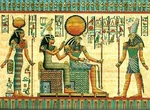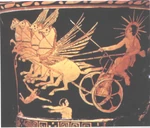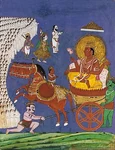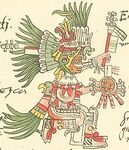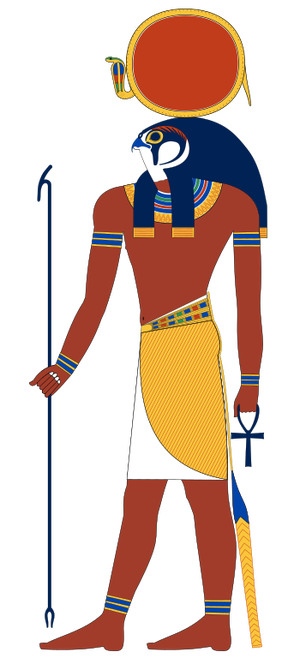
Ra, ancient Egyptian god of the sun and king of the gods.
A solar deity (also sun god or sun goddess) is a sky deity who represents the Sun, or an aspect of it, usually by its perceived power and strength. Solar deities and Sun worship can be found throughout most of recorded history in various forms. The Sun is sometimes referred to by it's Latin name Sol or by its greek name Helios. The english word sun stems from Proto-Germanic *sunnǭ.
Mythology[]
Egyptian mythology[]
The primary solar deity of Egyptian mythology is Ra. However, Horakhty and his wife Amentet, are gods of the rising sun and Khepri is god of the morning sun and Atum of the evening sun.
Greek mythology[]
In Greek mythology, Helios has the title of sun god. However Apollon is also considered a god of the sun. Eos, sister of Helios, is goddess of the Dawn.
Norse mythology[]
In Norse mythology, Dagr is the god of the day. However Sól is the goddess of the sun.
Hindu mythology[]
In Hindu mythology, Surya is god of the sun and it's power. However, the Adityas, the seven solar deities, are lesser gods of the sun. The Suryawanshi dynasty claimed descendancy from him.
Aztec mythology[]
In Aztec mythology, Huitzilopochtli is considered god of the sun, as well as god of war and sacrifice. Tonatiuh is considered og of the movements of the sun.
Incan mythology[]
In Incan mythology, Inti is the supreme sun god, and is ancestor of the Inca emperors and all humans. He is son of Viracocha, god of creation, and is patron of the Inca Empire.
Japanese mythology[]
In Japanese myth, Amaterasu is the sun goddess and ancestress of the Emperors of Japan. She famously hid in a cave and had to be enticed outside by her fellow immortals.
Mesopotamian mythology[]
In Mesopotamian mythologies, such as those of Assyria, Sumeria and Babylon, Shamash is the solar deity. However, the god of the underworld, Nergal, is also considered a solar deity.


